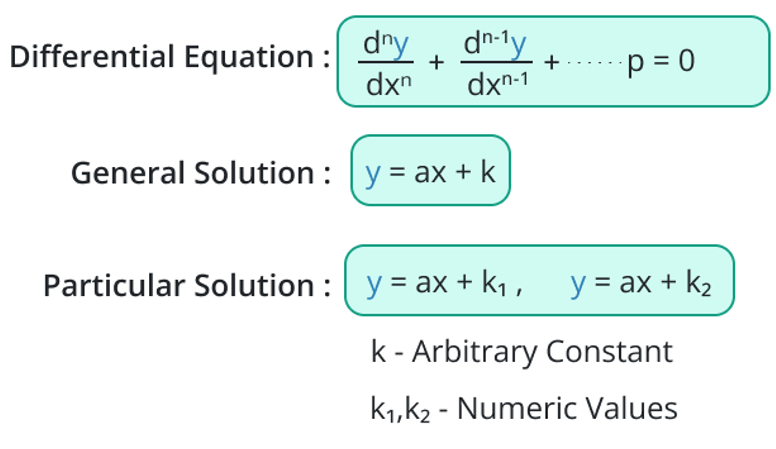To calculate result you have to disable your ad blocker first.
Differential Equation Calculator
Select the term, enter the required values, and hit calculate button to use differential equation calculator
Differential Equation Calculator
Differential Equation Calculator is a tool that is used to solve the differential equation of any order by putting the initial point’s value and without the point’s value.
What are Differential Equations?
It contains one or more unknown functions and involves the derivative of the independent variable with respect to the dependent variable. It also shows the rate of change of a function to the respective initial value and possibly other variables.

It determined the changes in the model, the behavior of atom molecules, the growth of populations, and the flow of fluids.
The general form of differential equation is represented as,
F (x, y, y’, y’’,..., y(n)) = 0
Where,
- x = independent variable of the function
- y = dependent on “x” function
- y’ = 1st-derivative of y with respect to x
- y’’ = 2nd-derivative of y with respect to x
- .
- .
- .
- y(n) = nth- derivatives of y with respect to x
Types OF Differential Equations:
There are two basic types of differential equations involving the independent variables.
- (ODEs) Ordinary differential equations
- (PDEs) Partial differential equations
(ODEs) Ordinary differential equation:
It contains a derivative with respect to the single independent variable and contains one or more unknown functions. In a simpler way say that it deals with the functions of one variable.
The order of ODEs is dependent on the highest derivative that is present in the given equation. The first-order equation contains the first-order derivative while the 2nd order differential equation involves the derivative of the second order with respect to the independent variable and similarly the order varies due to the coming of the derivative.
(PDEs) Partial differential equation:
It contains a derivative with respect to one or more independent variables and contains one or more unknown functions. In a simpler way say that it deals with the functions of one or more variables.
Differential Equation by the order:
Differential equations are distributed in different types based on their order which is identified by the highest derivative present in the equation.
Differential Equations of 1st-Order:
1st-order equations involve the first derivative of the unknown function. The formula of the first is stated as
dy/dx = f(x, y)
Or
y’ = f(x, y)
Where, y is the respective function and f(x, y) represents a function of both x and y.
Differential Equations of 2nd-Order:
2nd-order equations involve the derivative up to the 2nd order of the unknown function.
d2y/dx2 = f(x, y, dy/dx)
Or
y’’ = f(x, y, y’)
Where, y is the respective function and f(x, y, y’) represents a function of both x and y. Moreover, “ y’ ” represents the 1st-derivative.
(H-DEs) Higher-Order Differential Equations:
Higher-order equations involve derivatives of orders of more than two. It contained 3rd-order, 4th-order, and so on. The general form for an nth-order differential equation is stated as,
y(n) = f(x, y, y’, y’’, ..., y(n-1))
Where y(n) shows the nth derivative of y with respect to “x”.
Example section:
Here we solved some examples to explain the tool.
Example 1:
Find the solution of a differential equation using a suitable method.
y’(x) + y(x)=0
Solution:
Step 1:
Write the equation in the form of the standard derivative.
{dy(x)/d(x)} + y(x)=0
Step 2:
Evaluate the equation by separable technique.
{dy(x)/d(x)} = - y(x)
dy(x)= - y(x)d(x)
dy(x)/y(x)= - dx
Step 3:
To simply the above expression place the integral on both sides.
∫ {1/y(x)}dy= -∫ dx
ln(y(x)) = -x +c
Step 4:
To find the value of “y(x)” apply the exponential sign on both sides.
e[ ln(y(x)) ] = e [-x +c]
y(x)= e [-x +c]
Example 2:
Find the solution of the differential equation using a suitable method.
y’(x) + 4y(x) = 2
Solution:
Step 1:
Write the equation in the form of the standard derivative.
{dy(x)/d(x)} + 4 y(x) = 2
Step 2:
Evaluate the equation by separable technique.
{dy(x)/d(x)} = - 4y(x) +2
dy(x)= [2 - 4y(x)] d(x)
dy(x)/ [2 - 4 y(x)] = dx
Step 3:
To simply the above expression place the integral on both sides.
∫ {1/[2 - 4 y(x)] } dy = ∫ dx
(-4) ln{[2 - 4 y(x)]} = x +c
To simplify the equation divide by “-4” on both sides.
ln{[2 - 4 y(x)]} = (x/-4) + (c/-4)
ln{[2 - 4 y(x)]} = (-x/4) + c’
Step 4:
To find the value of “y(x)” apply the exponential sign on both sides and simplify.
e ln{[2 - 4 y(x)]} = e[(-x/4) + c’]
[2 - 4 y(x)] = e[(-x/4)] e[c’]
Replace the “e[c’]” with the new constant “C”.
[2 - 4 y(x)] = C e[(-x/4)]
Distribute the values to make the coefficient free “y(x)”.
-4y(x) = C e[(-x/4)] – 2
Divide by the “-4” on both sides.
y(x) = C e[(-x/4)]/(-4) – 2/(-4)
y(x) = -(C/4) e[(-x/4)] + 1/2

